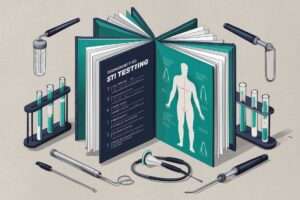The Ultimate Guide to Anal STI Testing and Safer Sex Practices
When it comes to sexual health, many people focus solely on genital testing for sexually transmitted infections (STIs). However, anal STI testing is an equally important aspect of comprehensive sexual health care that’s often overlooked. This guide will explore everything you need to know about anal STI testing, including why it’s important, what to expect, and how to protect yourself.

Table of Contents
ToggleWhy Anal STI Testing Matters
Anal sex is a common sexual practice among people of all genders and sexual orientations. However, it’s important to understand that the anal area is particularly susceptible to STIs. Here’s why:
- Delicate tissue: The lining of the anus and rectum is thin and can easily tear during sexual activity, providing an entry point for infections.
The Ultimate Guide to Using Condoms: Everything You Need to Know for Safe and Enjoyable Sex
- Lack of natural lubrication: Unlike the vagina, the anus doesn’t produce its own lubrication, increasing the risk of micro-tears.
- Higher STI prevalence: Some studies suggest that STI rates may be higher among people who engage in anal sex.
- Asymptomatic infections: Many STIs can be present in the anal area without causing noticeable symptoms, making regular testing crucial.
Common STIs Transmitted Through Anal Sex
Several STIs can be transmitted through anal sex. Some of the most common include:
Chlamydia and Gonorrhea
These bacterial infections can infect the rectum and often don’t cause symptoms. When symptoms do occur, they may include rectal pain, discharge, or bleeding.
HIV
The human immunodeficiency virus can be transmitted through anal sex, with receptive partners at higher risk due to the potential for tissue damage.
Human Papillomavirus (HPV)
HPV can cause genital warts and increase the risk of anal cancer. Regular screening is especially important for those at higher risk.
How Long Does It Take for Chlamydia to Show Up? Understanding the Timeline and Symptoms
Herpes Simplex Virus (HSV)
Both HSV-1 and HSV-2 can cause anal herpes, which may present as painful blisters or sores around the anus.

Hepatitis B and C
These viral infections affecting the liver can be transmitted through anal sex, especially if there’s any bleeding involved.
Who Should Get Anal STI Testing?
Anal STI testing is recommended for:
- Anyone who engages in receptive anal sex
- Men who have sex with men (MSM)
- People with multiple sexual partners
- Individuals with known exposure to an STI
- Those experiencing symptoms in the anal area
It’s important to note that even if you use protection during anal sex, regular testing is still recommended as condoms aren’t 100% effective in preventing all STIs.
Sexually Transmitted Infections (STIs): A Comprehensive Guide to Understanding, Prevention and Treatment
Types of Anal STI Tests

Several types of tests can be used to detect STIs in the anal area:
Swab Tests
A healthcare provider will use a cotton swab to collect a sample from the anus or rectum. This test can detect bacterial infections like chlamydia and gonorrhea.
Blood Tests
Blood tests are used to detect HIV, syphilis, and hepatitis B and C.
Is Scabies an STD? Understanding the Facts About This Contagious Skin Condition
Visual Examination
A healthcare provider may visually examine the anal area for signs of warts, herpes lesions, or other visible symptoms.
Anal Pap Smear
Similar to a cervical Pap smear, this test can detect abnormal cell changes that might indicate HPV infection or early signs of anal cancer.
What to Expect During Anal STI Testing?
If you’re considering anal STI testing, here’s what you can expect:
- Consultation: Your healthcare provider will ask about your sexual history and any symptoms you may be experiencing.
- Physical examination: The provider may examine your anal area for any visible signs of infection.
- Sample collection: Depending on the tests being performed, the provider will collect samples using swabs or draw blood.
- Follow-up: You’ll typically receive your results within a few days to a week, depending on the tests performed.
Remember, healthcare providers are professionals trained to perform these tests with sensitivity and discretion. There’s no need to feel embarrassed or ashamed about requesting anal STI testing.
Dental Dams: The Ultimate Guide to Safer Oral Sex
How Often Should You Get Tested?
The frequency of anal STI testing depends on your individual risk factors. Here are some general guidelines:
- Annually for sexually active individuals with a single, long-term partner
- Every 3-6 months for those with multiple partners or engaging in higher-risk behaviors
- Immediately if you experience symptoms or have had known exposure to an STI
Always consult with your healthcare provider for personalized recommendations based on your specific situation.
Preventing STIs During Anal Sex
While regular testing is crucial, prevention is equally important. Here are some strategies to reduce your risk of anal STIs:

- Use condoms consistently and correctly
- Apply plenty of water-based lubricant to reduce friction and tissue damage
- Consider using dental dams for anal-oral contact
- Get vaccinated against preventable STIs like HPV and hepatitis B
- Communicate openly with partners about sexual health and testing status
- Consider pre-exposure prophylaxis (PrEP) if you’re at high risk for HIV
Overcoming Stigma and Seeking Care
Unfortunately, stigma surrounding anal sex and STI testing can prevent some people from seeking necessary care. It’s important to remember that:
- Anal sex is a common and normal sexual practice
- Healthcare providers are trained to offer non-judgmental care
- Your sexual health is an important part of your overall well-being
- Early detection and treatment of STIs can prevent serious health complications
If you’re uncomfortable discussing anal STI testing with your regular healthcare provider, consider seeking out LGBTQ+ friendly clinics or sexual health specialists who may be more experienced in this area.
Conclusion:
Anal STI testing is a crucial component of comprehensive sexual health care for anyone engaging in anal sex. By understanding the importance of testing, knowing what to expect, and taking preventive measures, you can protect yourself and your partners from STIs. Remember, there’s no shame in prioritizing your sexual health – regular testing and open communication are key to maintaining a safe and enjoyable sex life.
References to External Sources:
- Centers for Disease Control and Prevention (CDC) – STD Risk and Oral Sex: https://www.cdc.gov/std/healthcomm/stdfact-stdriskandoralsex.htm
- World Health Organization (WHO) – Sexually Transmitted Infections (STIs): https://www.who.int/news-room/fact-sheets/detail/sexually-transmitted-infections-(stis)
- National LGBT Health Education Center – Taking Routine Histories of Sexual Health: https://www.lgbtqiahealtheducation.org/wp-content/uploads/2016/09/Sexual-Health-History-Toolkit.pdf
- American Sexual Health Association – STI Testing: http://www.ashasexualhealth.org/stdsstis/get-tested/
- UNAIDS – HIV Prevention: https://www.unaids.org/en/topic/prevention


